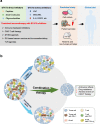Targeting STAT3 in Cancer Immunotherapy
- PMID: 32972405
- PMCID: PMC7513516
- DOI: 10.1186/s12943-020-01258-7
Targeting STAT3 in Cancer Immunotherapy
Abstract
As a point of convergence for numerous oncogenic signaling pathways, signal transducer and activator of transcription 3 (STAT3) is central in regulating the anti-tumor immune response. STAT3 is broadly hyperactivated both in cancer and non-cancerous cells within the tumor ecosystem and plays important roles in inhibiting the expression of crucial immune activation regulators and promoting the production of immunosuppressive factors. Therefore, targeting the STAT3 signaling pathway has emerged as a promising therapeutic strategy for numerous cancers. In this review, we outline the importance of STAT3 signaling pathway in tumorigenesis and its immune regulation, and highlight the current status for the development of STAT3-targeting therapeutic approaches. We also summarize and discuss recent advances in STAT3-based combination immunotherapy in detail. These endeavors provide new insights into the translational application of STAT3 in cancer and may contribute to the promotion of more effective treatments toward malignancies.
Keywords: CAR-T; Cancer; Immune checkpoint blockade; Immunosuppression; Immunotherapy; STAT3.
Conflict of interest statement
The authors declare that they have no competing interests.
Figures



References
Publication types
MeSH terms
Substances
LinkOut - more resources
Full Text Sources
Other Literature Sources
Medical
Research Materials
Miscellaneous

